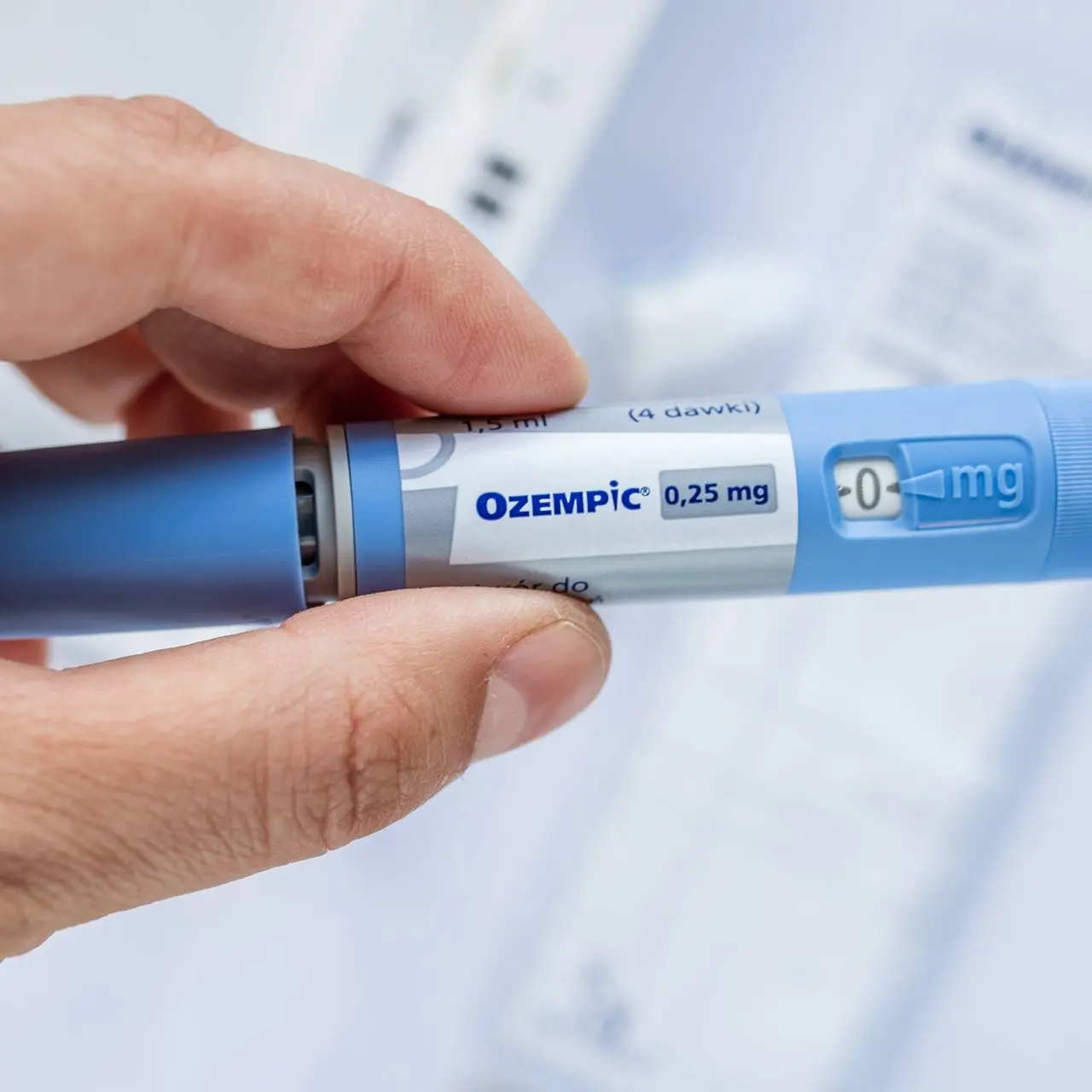Blog
Who Can Get A Prescription For Ozempic In The EU
Who Can Get A Prescription For Ozempic In The EU?
In the EU, Ozempic is approved for type 2 diabetes. Adults with a BMI of 30+, or 27+ with weight-related conditions, may also qualify off-label. Doctors assess a patient’s medical history, risks, and lifestyle factors before prescribing treatment.

MD, PhD, Internal Medicine Specialist and Cancer Immunology Researcher.
What Is Ozempic and How Does It Work?
Ozempic is a medication approved for managing diabetes. It is currently not approved for weight loss in the EU. The active ingredient in Ozempic is semaglutide, a type of glucagon-like peptide-1 (GLP-1) receptor agonist. This means it works by stimulating the GLP-1 receptor in the body, which helps regulate blood sugar levels and promote weight loss.
Semaglutide is a synthetic or lab-generated version of a hormone that occurs naturally in the body. This hormone is called glucagon-like peptide-1 (GLP-1), which is produced by the intestines in response to food intake. GLP-1 helps patients regulate blood sugar levels by stimulating the release of insulin and inhibiting the release of glucagon, a hormone that increases blood sugar levels in response to low insulin. GLP-1 also decreases the rate at which food leaves the stomach, which can help to reduce appetite and promote feelings of fullness.
Ozempic is administered as a subcutaneous injection once a week. It must be injected under the skin rather than taken as a pill like other prescriptions. This slow-release formulation enables a sustained effect, regulating blood sugar levels and promoting weight loss. It is essential to follow the prescribed dosing and administration instructions carefully to achieve the maximum benefits of the medication.
Ozempic is not a substitute for a healthy diet and regular exercise. Instead, it is a tool that people should use in conjunction with these lifestyle changes to help promote weight loss. So, before starting Ozempic, we would like to discuss your medical history and weight loss goals with a licensed healthcare provider, which is crucial to ensure that it is a safe and appropriate treatment option.
In the following sections, I’d like you to please learn about the uses and side effects of Ozempic and the process for obtaining a prescription from a healthcare provider.
Who Should Not Take Ozempic?
While Ozempic can be an effective obesity treatment, it is vital to note that specific contraindications may make it unsuitable for certain individuals. A contraindication is a particular circumstance or condition that makes the use of a medication inadvisable due to the risk of harm or adverse effects.
One of the main contraindications for Ozempic is a history of medullary thyroid carcinoma (MTC) or multiple endocrine neoplasia syndrome type 2 (MEN 2). These are rare but severe types of thyroid cancer that can be associated with mutations in the RET gene. Because Ozempic can cause thyroid tumours in rats and mice, there is a theoretical risk that it could increase the risk of MTC in humans with these underlying genetic mutations. Therefore, Ozempic is not recommended for individuals with an MTC or MEN 2 history. Another contraindication for Ozempic is a known hypersensitivity or allergy to semaglutide or its components. Allergic reactions can be life-threatening, so it is crucial to avoid Ozempic if you have had an allergic reaction to it or any similar medications in the past.
Ozempic is also contraindicated in individuals with severe gastrointestinal diseases, such as gastroparesis or inflammatory bowel disease (IBD). These conditions can affect the absorption and distribution of medications in the body, potentially increasing the risk of adverse effects or interfering with the efficacy of Ozempic. Additionally, it is essential to use caution when taking Ozempic with a history of pancreatitis or gallbladder disease, as these conditions can increase the risk of severe adverse effects. All people interested in taking Ozempic should discuss their medical history and any underlying conditions with a licensed healthcare provider before starting the medication to determine whether it is a safe and appropriate treatment option for them.
Common and Serious Side Effects of Ozempic
Like all medications, Ozempic can cause side effects, although not everyone who takes it will experience them. Nausea, vomiting, and diarrhoea are common consequences of Ozempic, followed by constipation and abdominal pain, but can easily be avoided with medication.
They are generally mild to moderate in severity and may improve over time as the body adjusts to the medication.
Other common side effects of Ozempic include headache, dizziness, fatigue, and injection site reactions, such as pain, swelling, and redness at the injection site. These side effects are generally not severe and do not require medical attention unless they persist or become bothersome.
In rare cases, Ozempic can cause more severe side effects, such as pancreatitis, gallbladder disease, thyroid tumours, and hypoglycemia, which is low blood sugar. Pancreatitis is a serious condition that can cause severe abdominal pain, nausea, and vomiting and may require hospitalisation. Gallbladder disease can cause symptoms such as abdominal pain, bloating, and indigestion and may require surgery in some cases.
Thyroid tumours are rare but potentially severe side effects of Ozempic, particularly in individuals with a history of medullary thyroid carcinoma (MTC) or multiple endocrine neoplasia syndrome type 2 (MEN 2). Therefore, discussing any risk factors for thyroid tumours with a licensed healthcare provider before starting Ozempic is essential.
Hypoglycemia can occur if the dose of Ozempic is too high or combined with other medications that lower blood sugar levels. People with hypoglycemia may display shakiness, dizziness, sweating, confusion, and fainting, which can be severe if left untreated.
Any side effects of Ozempic should be reported to a licensed healthcare provider, particularly if they persist or become bothersome. A healthcare provider may adjust your dose or recommend other treatments to help manage these side effects. In some cases, if symptoms are too severe, it may be necessary to discontinue Ozempic and switch to another treatment option. Though Ozempic can be an effective treatment for some people who struggle with obesity, users must be aware of the potential side effects, both common and rare. By working closely with a licensed healthcare provider and reporting any side effects promptly, you can help minimise the risk of serious adverse effects and ensure the most effective and safe treatment possible.
Medical Requirements for an Ozempic Prescription
Before a healthcare provider prescribes Ozempic, they typically perform a comprehensive medical evaluation to assess whether it is safe for the patient. This evaluation may include reviewing the patient’s medical history.
One of the critical requirements for receiving a prescription for Ozempic is an obesity diagnosis or difficulty in losing weight, often due to inadequate blood sugar control. Ozempic is approved for diet and exercise alone in adults without weight loss. Furthermore, adults with a BMI of 30 or higher, or those with a BMI of 27 or greater and at least one weight-related medical condition, may be suitable candidates. Such weight-related conditions may include, but are not limited to, type 2 diabetes, high cholesterol, and hypertension.
In addition to the criteria mentioned above, doctors must determine whether it is safe for the patient to receive a prescription for Ozempic. These may include:
- A review of the patient’s medical history, including any allergies, medical conditions, and medications currently being taken.
- Physician assessment of overall health and any potential contraindications for Ozempic use, such as thyroid tumours or pancreatitis.
- A discussion of potential side effects and risks associated with Ozempic use, as well as any other treatment options that may be appropriate.
- A commitment to ongoing monitoring and follow-up to ensure the medication is effective and safe for the patient.
It is also essential to note that Ozempic is a prescription medication and can only be obtained with a valid prescription from a licensed healthcare provider. This means that patients must have regular appointments with their doctor to get refills and to monitor their health while taking the medication. Overall, the requirements for receiving a prescription for Ozempic ensure that the drug is appropriate and safe for the patient.
Who Qualifies for Ozempic in the EU
| Qualification Criteria | Description |
|---|---|
| BMI of 30 or more | Considered obese; may qualify for weight management support |
| BMI of 27+ with risk factors | Must include conditions like type 2 diabetes or hypertension |
| No thyroid cancer history | Must not have MTC or MEN 2 |
| No recent pancreatitis | Recent or chronic pancreatitis may disqualify usage |
| Committed to lifestyle changes | Ozempic is not a replacement for diet and exercise |
How to Get an Ozempic Prescription in the EU
Getting a prescription for Ozempic typically involves several steps, including a comprehensive medical evaluation and ongoing monitoring.
Here are the general steps involved in obtaining an Ozempic prescription:
Schedule an Appointment with a Healthcare Provider
The first step in obtaining an Ozempic prescription is to schedule an appointment with a licensed healthcare provider. This may be a primary care physician, endocrinologist, or another medical professional authorised to prescribe medication.
Discuss Your Medical History and Symptoms
During your appointment, your healthcare provider will likely ask you about your medical history and any symptoms you may be experiencing. This will help them determine if Ozempic is an appropriate treatment option for you.
Discuss Potential Treatment Options
If your healthcare provider determines that Ozempic is an appropriate treatment option for you, they will likely discuss the potential benefits and risks of the medication, as well as any alternative treatment options that may be available.
Receive A Prescription And Instructions For Use
If you and your healthcare provider decide that Ozempic is an appropriate treatment option, you will be prescribed it. Your healthcare provider will provide detailed instructions for use, including dosage, administration, and potential side effects.
Schedule Regular Follow-Up Appointments
It is essential to schedule regular follow-up appointments with your healthcare provider to monitor your health and ensure that the medication is working effectively and safely. Your healthcare provider may also adjust your dosage or treatment plan as needed.
Collaborating with a licensed healthcare professional and following the steps mentioned above can help you obtain a prescription for Ozempic and ensure optimal and secure treatment for overweight individuals with diabetes.
FAQ
Can I get Ozempic if I don’t have diabetes?
Yes. If your BMI is 30 or higher, or 27 with weight-related conditions, a doctor may prescribe Ozempic off-label.

